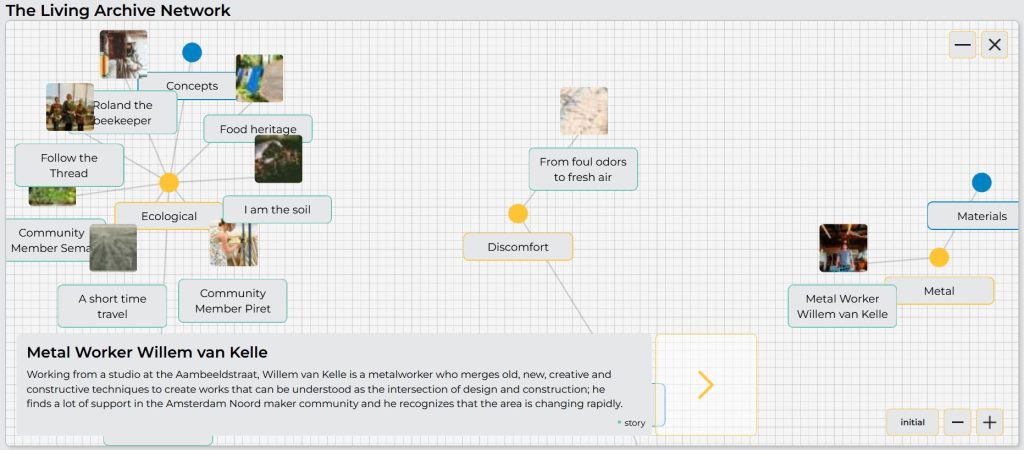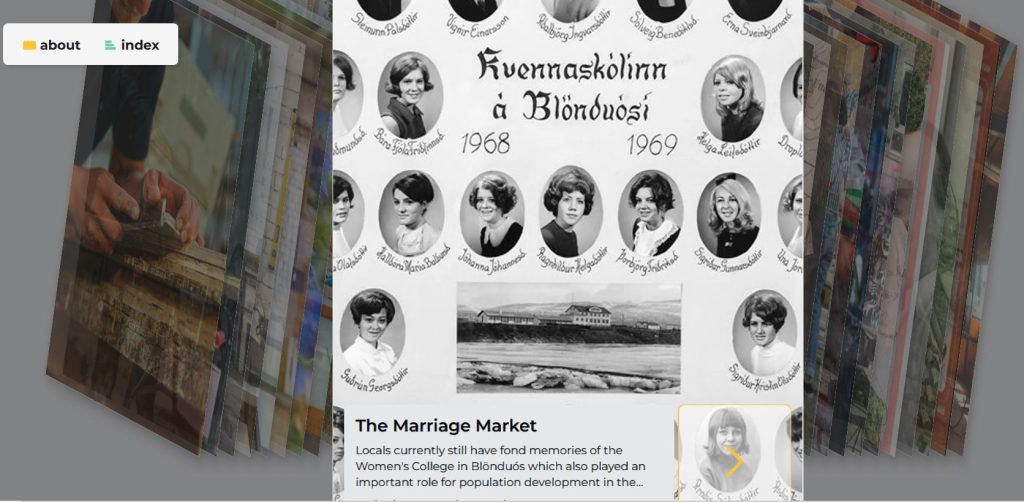BLOG
Like a jukebox of stories
Like a jukebox of stories
PRESS RELEASE
CENTRINNO PROJECT LAUNCHES THE LIVING ARCHIVE, CONNECTING STORIES ACROSS EUROPE FOR A CIRCULAR AND INCLUSIVE FUTURE
- The Living Archive explores the 9 pilot cities across Europe in their collection of stories with participatory heritage methods.
- The research project CENTRINNO (New CENTRalities in INdustrial areas as engines for inNOvation and urban transformation) is currently in its 4th and final year of the project, getting close to achieving its objectives.
- The project’s output is an open access platform to enable the creation of inclusive and circular hubs: the Fab City Hubs.
June 20, 2023. CENTRINNO EU launches to the public the project’s resource Living Archive, the newest CENTRINNO output, which is now available at living archive.centrino.eu. On the occasion of the CENTRINNO Consortium Meeting in Copenhagen on 23-25 May, a first soft launch took place and the new tool is now accessible from CENTRINNO Homepage.
The Living Archive is a great addition on CENTRINNO’s operative resources to facilitate transformation processes across historic areas, among them we have the already released Cartography and Fab City Hub Toolkit resources.
Project Manager, Dr. Pietro L. Verga, highlights the achievements of CENTRINNO project and its new output: “With nearly 34 months of implementation in the books, CENTRINNO is approaching the summer with a full sense of satisfaction and accomplishment, as all planned targets and goals for have thus far been met by the 26 partners of the Consortium.”
While the nine city pilots are engaged in the development of their third and last sprint at local level, the project goes on with the delivering of new tools in line with CENTRINNO’s vision and mission. The new Living Archive output, after more than two years of work in the background and under the leadership of the Reinwardt Academy at the Amsterdam School of Arts, represents a fundamental asset for CENTRINNO. In fact, as well explained by the Project Manager, Dr. Pietro L. Verga “it allows to preserve and valorise the social and cultural heritage of the pilot target areas and share the stories of our local communities and showcase the intrinsic heritage value of our pilot sites.”
What is the Living Archive?
This webspace brings together many stories collected by nine Fab City Hub teams from all over Europe. The collection has been carefully assembled by these teams who have been learning about, co-creating and applying participatory heritage-making approaches, emotion networking methodology, oral history principles and creative perspective-taking.
“Traces of the past are all around us and can be sources of inspiration for those seeking to transform society to be more inclusive, more just and more circular. But the question is: which past? whose past?”, explains Jonathan Even-Zohar, Researcher at the Reinwardt Academy. “The local teams of CENTRINNO have become critical co-curators by applying ethnographic fieldwork, using the methodology of Emotion Networking, conducting oral history research and testing participatory exhibition making approaches. Equipped with a kind of sensitivity and criticality toward how heritage is a quality label made in interaction, the pilot teams have collected many stories representative of even more voices and perspectives. We are extremely glad to have launched the online Living Archive space which is designed to encourage further exploration of the relational nature of stories and which will only keep growing with more stories.”
Heritage making as a potential
The CENTRINNO project builds from and researches the potential of heritage to act as a catalyst for transforming urban society to be more circular and more inclusive. The point of departure for this are nine former industrial sites, and their heritage. But what is heritage?
Really. Ask yourself. What is heritage? To define it exactly might miss the point, given that almost anything could be heritage: landscapes, buildings, tools, traditions, artworks, waste, materials, and so on. It can be useful to think of heritage from its Latin etymological roots, as what is inherited from the past. Whether positively or negatively understood, whether claimed or marked as something that should denote a break from the past, BY REFERRING TO THE PAST, PEOPLE MAKE sense of their present and future.
Heritage is a concept, applied on both institutional and grass-roots levels to elements of the past that are confronted with rapid change, loss, and alienation, and as such always involves conflicting interests and emotions. Heritage is made, whether consciously or unconsciously, through preservation, attention, care, and remembering – or a lack thereof.
Connecting with and from a place
Heritage responds to a rapidly-changing world, therefore suggesting the question: what should be safeguarded as heritage, in the urgent era of climate change and growing socioeconomic inequality? This question is relevant in all nine pilot sites and beyond. Places which are known for their role in industrial production in previous centuries.
We seek the stories that comprise the lived reality of these sites, but which have not always been given equal weight, having been overlooked, unheard, unseen. Perhaps these can help us understand what heritage is and does today.
Whose story?
 Living Archive Network
Living Archive Network
Our Living Archive encompasses a growing number of stories from the nine pilot sites of CENTRINNO. Some of these delve into the sites’ histories, where others bring in present-day perspectives. Some of these present an observation from a narrator point of view, while others present the voice of a non-human entity. All of the stories have been collected and curated locally. The Living Archive celebrates this approach as each story added is justified by the local teams. As such, the collection does not attempt to build a wide database of histories, but a focused and ‘living’ collection which is aligned to the local efforts of the nine pilot teams.
Do you have stories or memories related to these buildings that you want to share with us? What do you feel is missing? Help us build this alternative history of making.
Relationships. Technically speaking
The Living Archive design and development, conceptualised by the Reinwardt Academy Research Group and A++ (of web designer Alessandro Amato), is detailed in the Living Archive Beta version – D2.5, available under the resource section.
Some key features of the chosen approach include:
- Stories are curated following a critical heritage approach and applying participatory methodologies, including Emotion Networking.
- Stories are conceived as a singular narrative each. To that end the project co-created a “one sentence summary” structure, to enable an easily identifiable structure underpinning each story.
- Each of the segments of the one-sentence-summary structure then forms a category for a multitude of tags. Thus harnessing connectivity among the tories.
- All stories together on the website, through the many tags, are put in one relational grid.
For example, take the story collected in Tallinn about Roland the Beekeeper. Though short in narrative, its many tags provide it a relational path to many other stories, either in relation to the making of a food, or the ecological values underpinning it.

Tallinn story: Roland the Beekeeper
Living is breathing
The now open Living Archive will in the rest of 2023 continue to collect and co-curate stories with the nine participating Fab City Hubs. Watch this space!
About CENTRINNO
With the industrial revolution, technology was introduced to society, creating significant economic benefits to regional and national economies. However, globalisation resulted in European cities losing a large volume of their manufacturing capacity, transitioning into a knowledge economy. As a consequence, manufacturing jobs have decreased and neglected industrial areas have fallen into decay. The EU-funded CENTRINNO is a Horizon 2020 project aiming to develop and demonstrate strategies, approaches and solutions for the regeneration of industrial historic sites and areas as creative production and manufacturing hubs that stay true to the ecological challenges of our time. The areas will also boost a diverse, inclusive and innovative urban economy and use heritage as a catalyst for social inclusion.
Download the Press Release here.
Discover the previous Press Release on the Cartography here.
For media inquiries please contact: [email protected]
Social media:
- Twitter: https://twitter.com/CentrinnoEU
- LinkedIn: https://www.linkedin.com/company/centrinnoeu
- Instagram: https://www.instagram.com/centrinnoeu/
- Facebook: https://www.facebook.com/centrinnoeu/
- YouTube: https://www.youtube.com/@centrinnoeu
This project has received funding from the European Union’s Horizon 2020 Research and Innovation programme under grant agreement number 869595.
































































































